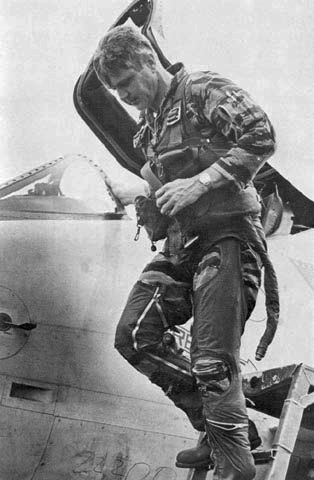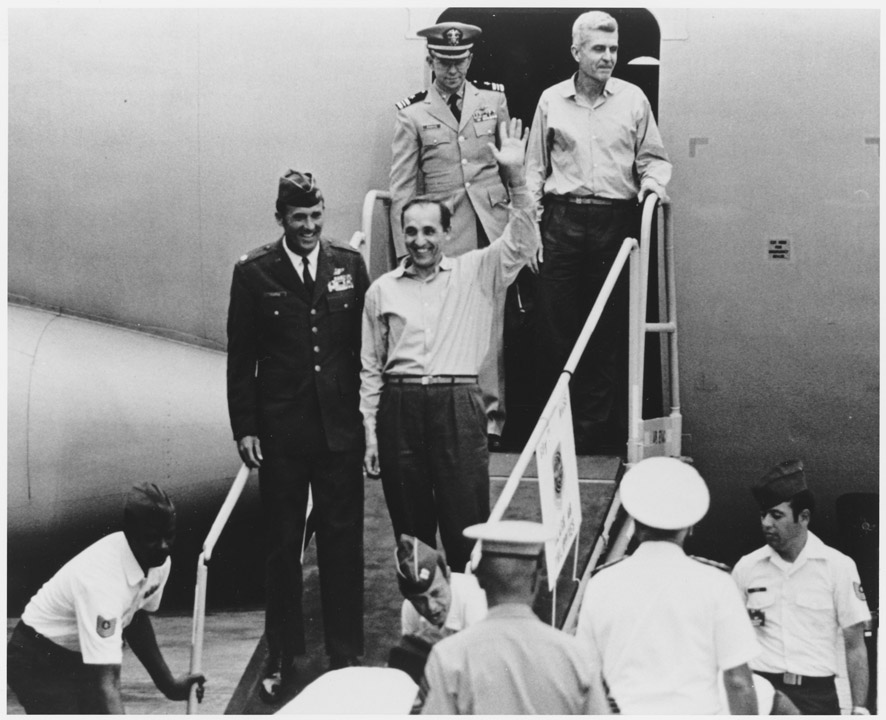James Stockdale
James Bond Stockdale, US Naval Academy Class of ’47, is the embodiment of leadership and inspiration, as well as the perfect naval aviator. Admiral Stockdale is one of the most highly decorated officers in the naval service and received the Medal of Honor for his performance of duty during his eight years as a prisoner of war in North Vietnam.
Prisoner of War
On September 9, 1965, he was shot down while flying a VA-163A-4E Skyhawk. He became the senior Navy prisoner of war confined in Hanoi’s infamous Hao Lo prison. Because Stockdale assumed command of the Prisoners of War (POWs) and exercised underground organizational leadership in defiance of his captors’ orders, he was subjected to 15 torture sessions throughout his two years in leg irons and four years in solitary confinement. For purposefully hurting himself almost to death to convince the North Vietnamese that he would sooner die than give in to their demands, Stockdale was granted the Medal of Honor.
Permanently disabled
During his incarceration, he was promoted to captain and got significant medical care for injuries sustained during his ejection and subsequent torture. He was released on February 12, 1973. Despite having a locked left knee joint as a result of these injuries that left him permanently disabled, then-RADM Stockdale was able to resume his naval career when he took over as commander of Antisubmarine Warfare Wing Pacific in January 1974. Prior to concluding his 37-year active service career with a 1979 return as vice admiral, he served as president of the Naval War College.
Stockdale recalls his final mission for Carrier Air Group Commanders by Robert L Lawson.

Strike against Thanh Hoa railway bridge
Stockdale led a strike against the problematic, nearly legendary Thanh Hoa railway bridge on September 9, 1965, using his A-4E. However, bad weather rendered the original plan unfeasible, so Stockdale sent the various elements in search of secondary targets.
“I had neglected to mention to Wynn Foster, XO of VA-163, who found himself on my wing, what exactly our alternate target would be. I remember we loitered offshore listening to VA-163 CO Harry Jenkins’ division comparing notes on their detections of SAM radars, on their just-acquired gear, flying in the soup, down near Vinh. That SAM was the southern-most one yet detected, I believe.
Getting rid of the bomb load
“I knew of a place where we could normally get rid of a bomb load into a worthwhile target without prior arrangements, and with surprisingly little flak: a railroad siding four or five miles west of Highway 1, about 15 miles south of Thanh Hoa. The ceiling was low up there and, since Wynn and my planes had 500-pound bombs with an option switch for snakeye or steep dive delivery, we went in under the clouds. We proceeded up the coast past our target, then swung west to a nice ‘180’ turning point, and swept in to line up on those beautiful boxcars.
“I didn’t even have my oxygen mask snapped across my face. We were coming in flat, in trail, right on the deck at about 500+ indicated, I, and undoubtedly Wynn, both totally relaxed. I had pulled this foul-weather snakeye maneuver on this same train parking area a couple of days before and got no flak.
James Stockdale ejection
“Then I heard it!! ‘Boom, Boom, Boom, Boom!’ I knew right where to look—the noise came from two o’clock. And there it was, firing at me point blank, 200 yards at three o’clock. It was, I think, a 57mm mobile cannon. I watched it belching fireballs directly at me and, by the time I recognized all this, every red light in my cockpit was on and pulsating: fire! Hydraulics gone! Everything unwinding!
“I had to get that oxygen mask up to give Wynn a Mayday. That took an instant, and by that time the plane was out of control with me just along for the ride. The stick didn’t work, and I was heading for the deck. The confusion of `g’ forces interrupted my grabs for the curtain, so I went for the alternate handle between my legs. I remember craning my head back to see the chute blossom, and a strange feeling coming over me as I watched the chute unravel that `something about that ejection was just not right.’
‘American Air Pirate’
“I later figured I had ‘sensed’ something awry with my bones; I had forgotten to grab my right wrist with my left hand, and it was hours later before I realized I couldn’t raise my left arm. Instantaneous wind blast flail, of which I was never conscious, had broken bones in my left shoulder and back. But I had a lot more going through my mind than checking bone structure.
“Even when, seconds later, I touched down right on the main street of a little country town named Tin Gia (just after I floated over highway one), longing for that open ocean I could see less than a mile ahead, I could hear feet pounding down the street. Then I caught them out of the corner of my right eye at three o’clock—the town’s rough-necks, sprinting forward, just about to gang tackle this ‘American Air Pirate.’ It was maybe two minutes before the police whistle started to blow. The pummeling and gouging and twisting suddenly stopped, and I was sat up in the street and motioned to disrobe by the pith-helmeted official.
Crippled for life
“Eventually I saw my left leg—broken at the knee and sticking out at a right angle toward nine o’clock. Crippled for life! I knew it in an instant. What a letdown.
“You see, between the time I pulled the ejection handle and came to rest in that main street, I had become a man with a mission. I can’t explain this without unloading a little emotional baggage that was part of my military generation’s legacy in 1965.
Every man for himself
“In the aftermath of the Korean War, just over 10 years before, we all had memories of reading about and seeing early television news accounts of U.S. government investigations into the behavior of some American prisoners of war in North Korea and Mainland China. There was a famous series of articles in the ‘New Yorker’ magazine that later became a book entitled In Every War But One!’ The gist of it was that in the prison camps for Americans, it was every man for himself.

“Since those days, I’ve come to know officers who were prisoners of war there, and I now see much of that reporting as selective and a bum rap. However, there were cases of young soldiers who were confused by the times, scared to death, in cold weather, treating each other like dogs fighting over scraps, throwing each other out in the snow to die and nobody doing anything about it.
The American Fighting Man’s Code of Conduct
“This situation could not go on, and President Eisenhower commissioned the writing of the American Fighting Man’s Code of Conduct to guide future POWs.
“It is written in the form of a personal pledge. Article Four: ‘If I become a prisoner of war, I will keep faith with my fellow prisoners. I will give no information or take part in any action which might be harmful to my comrades. If I am senior, I will take command. If not, I will obey the lawful orders of those appointed over me and will back them up in every way.’ In other words, as of the moment Eisenhower signed the document, American prisoners of war were never to escape the chain of command; the war goes on behind bars.
The only wing commander to survive an ejection
“As an insider, as CAG aboard Oriskany, I knew the whole setup—that the North Vietnamese already held about 25 prisoners, probably in Hanoi and, that as the only wing commander to survive an ejection, I would be their senior—their commanding officer—and would remain so, very likely, throughout this war that I felt sure would last at least another five years. And here I was starting off crippled and flat on my back.
“All told, the disaster of this business of my being impeded in my duty by being permanently crippled, was only a temporary set-back from things that were important to me. Being cast in the role of sovereign head of an American expatriate colony that was destined to remain autonomous, out of communication with Washington, for years on end, was very important to me. Months later, I was 42 years old, still on crutches, dragging a leg, at considerably less than my normal weight, with hair down near my shoulders, my body unbathed since before I was catapulted from Oriskany and with a beard that had not seen a razor since I arrived, when I took command (clandestinely, of course—the North Vietnamese would never acknowledge our rank) of about 50 Americans.
James Stockdale, CAG for eight years
“That expatriate colony would grow to more than 450—all officers, all pilots or NFOs. I was determined to play well the given part. And all Americans continued to refer to me as ‘CAG’ until after I got home. “I was `CAG’ from February 1965, when on the eve of our departure for WestPac, I took the job at a ceremony on the flight deck of Oriskany alongside at North Island, until February 1973, when I arrived back at North Island after an eight-year absence. CAG—the boss of American flight crews—for eight full years. Can any-body top that?”
Official Citation for Medal of Honor recipient James Bond Stockdale
‘For conspicuous gallantry and intrepidity at the risk of his life above and beyond the call of duty while senior naval officer in the prisoner-of-war camps of North Vietnam. Recognized by his captors as the leader in the prisoners’ of war resistance to interrogation and in their refusal to participate in propaganda exploitation, Rear Adm. Stockdale was singled out for interrogation and attendant torture after he was detected in a covert communications attempt. Sensing the start of another purge, and aware that his earlier efforts at self-disfiguration to dissuade his captors from exploiting him for propaganda purposes had resulted in cruel and agonizing punishment, Rear Adm. Stockdale resolved to make himself a symbol of resistance regardless of personal sacrifice.
‘He deliberately inflicted a near-mortal wound to his person in order to convince his captors of his willingness to give up his life rather than capitulate. He was subsequently discovered and revived by the North Vietnamese who, convinced of his indomitable spirit, abated in their employment of excessive harassment and torture toward all the prisoners of war. By his heroic actions, at great peril to himself, he earned the everlasting gratitude of his fellow prisoners and of his country. Rear Adm. Stockdale’s valiant leadership and extraordinary courage in a hostile environment sustain and enhance the finest traditions of the U.S. Naval Service.’
Carrier Air Group Commanders is published by Schiffer Publishing and is available to order here.

Photo by U.S. Navy

